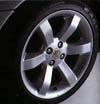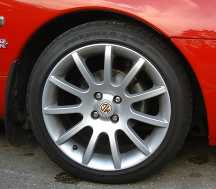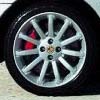
 |
Wheel options for the MGF and MGTF |
Original Wheel specifications for the MGF and TF |
P.C.D. | 95.25 mm | |
| Offset | 30 - 35 mm | ||
| Centre bore | 56.6 mm | ||
| 15" wheels: | 6J 15 | ||
| 16" wheels: | 7J 16 | ||
| Spare: | 5.5J 14 | ||
| Wheel nut torque | 90 Nm |
Caliper clearance: please note that when specifying wheels for your MG that large brake conversions may foul the wheel (especially the AP-racing/ MGF Trophy/ TF160 front calipers). Many of the standard wheels will cause problems - especially the original 8-spoke 15" alloy. The 11-spoke alloy styles offer the most clearance, whilst other 16" designs can be used in conjunction with wheel spacers - just be wary of the wheel's offset. If planning to use after market wheels, ensure that you discuss your requirements with the wheel supplier.
Wheel directory:
standard MG alloy wheels
Wheel weights are included for those wheels weighed by owners -
where estimates are provided (est), weight of wheel calculated from weighing the
wheel and tyre in combination, and removing the estimated weight of that
particular tyre.
MGF
| Wheel Description | Original Fitment | Wheel | Comments |
| 15" 8-spoke | 1.8i MPi 1995-1999 |
|
Original style MGF wheel. Nice, modern, 6- spoke alloy design. Has the worst clearance for calipers - something worth considering if you ever intend to upgrade your brakes. Weight: 7.8 kg |
| 15" 5-spoke | VVC 1995-1999 |
 |
A great looking 5-spoke design. Has fake Allen-bolt heads hinting that it is a split-rim design: it isn't. An interesting observation about its weight distribution though: the centre of gravity is towards the outer rim rather than central... Weight: 7.6 kg |
| 16" 6-spoke | Abingdon SE, MGF Cup cars, and optional extra. 1998- |
 |
First available style of 16" wheel on the MGF. Initially appearing on the Abingdon SE, it became so popular, that it became a permanent addition to the MGF/TF options list! Commonly found on the MGF Cup car racers. Weight: 7.3 kg |
| Multi-spoke 16" | 75LE, Wedgwood SE, Freestyle SE and optional extra. 1998-2002 |
 |
Became available as an option for the MGF at the same time as the Abingdon style 16" s-spoke wheel. Very attractive. Will need a 1.5mm spacer if used over the MG-AP racing brake and caliper combination. Weight: 7.5 kg (est) |
| 15" 8-spoke 'minilite' | MY2000 1.6 and 1.8 MPi. 1999- 2002 |
 |
'Entry level' alloy design for the MY2000 MGF. Found fitted to both the 1.6 and 1.8 MPi models. Design hints at the classic 'Minilite' style. In the author's opinion, possibly the weakest MGF wheel design. |
| 15" square spokes | Steptronic 2000- |
 |
Available as an upgrade option for cars fitted with the 'Minilite' style wheel, the design is similar to the larger 16" square spoke wheel. |
| 16" Square spokes | VVC 1999- 2002 |
 |
Perhaps the best looking wheel option available on the MY2000 MGF (and perhaps best looking MGF wheel overall? You decide). Weight: 8.0 kg (est) |
| 16" 11-spoke | Trophy 160 |  |
Manufactured for MG Rover by Tecnomagnesia. Attractive multi-spoke style in 16" diameter. Originally specified with Goodyear F1 tyres- 195/45 front 215/45 rear. Note that this wheel uses a different, non-standard centre wheel cap - so these need to be ordered at the same time as the wheel itself. Click here for distinguishing features of the genuine, MGR-specified wheel. Weight: 9.7 kg (est) |
MGTF |
|||
| 15" 8-spoke 'minilite' | 1.6 MPi |
 |
Wheel design carried over from the MGF. |
| 15" 6-square spoke | 135 and Stepspeed |
 |
Wheel design carried over from the MGF. |
| 16" new-style 11-spoke | 160 and optional extra |
 |
The TF brought with it this great looking 11-spoke alloy - a replacement for the 11-spoke design found fitted to the Trophy 160. Whereas the Trophy 160 wheel used a unique centre cap, the new design uses the MGR standard sized cap - much more convenient for those considering upgrading to these wheels. Weight: 9.7 kg (est) |
| 16" 6-spoke "Abingdon" | Optional Extra |
 |
Wheel design carried over from MGF. Weight: 7.3 kg |
| 16" anthracite multispoke | Optional Extra |
 |
Nice new variation on a classic MGF wheel theme, this wheel is the same casting as the MGF 16" multispoke design, but here available in an attractive metallic grey finish. A poor man's ULW wheel [see below]? Weight: 7.5 kg (est) |
| Ultra-Light weight (ULW) | Optional Extra |
 |
WOW! Absolutely brilliant looking new wheel introduced with the MGTF (sports pack 3). Uses aluminium alloy construction for lighter weight. Finished in anthracite for that more aggressive look. Stunning. Stunning price too - for the wrong reason: costs £1525.00 as a wheel option alone for the TF160. Gulp. Other interesting fact is that this wheel increases the wheel track, front and rear by 4mm - so front track becomes 1408mm and the rear becomes 1414mm. Weight: 6.0kg |
| 15" 'V'-spoke | 135 and Stepspeed auto |
 |
Introduced in 2005, this attractive 15" wheel design supersedes earlier 15" wheel designs in the TF range with the introduction of the MY2005 in Feb of that year. |
| 16" "Twist of Pepper" | 85LE |
 |
Introduced on the 85LE in 2009, this wheel is not only stunning to look at, but is unique in MGF/TF circles (no pun intended!) in having different widths front to rear (7J versus 7.5J rear). Manufactured by RimStock, they are finished in attractive "liquid boron" and are retrofitable to all MGF/TF derivatives. |
Definition of wheel terms: what does it all mean?
| P.C.D.
Pitch Circle Diameter PCD defines the diameter of the circle, whose circumference passes through the centre of each of the wheel stud holes (see figure opposite). On the MGF, this value is unique (the industry standard is 100mm, the MGF uses 95.25mm, common only to other MG Rover/ Austin Rover products). This makes ordering non-MG wheels for your car somewhat harder than it would normally be. If the PCD is incorrect, there is no way that you'll be able to bolt the wheel onto the car! Luckily this means that wheel theft from MGF/TFs is less than it might otherwise be - no spotty oik will be able to fit your wheels to his Nova (or Corsa!)... |
|
| Wheel
Offset Wheel offset defines the relationship between the mating face of the hub and wheel and the wheel centre line (as drawn through the wheel's width). See figure opposite. If a wheel has a zero offset, then the wheel and hub mating surfaces would be on the same line. A positive offset would see the mounting faces mate towards the outer edge of the wheel, whilst a negative offset would be in the opposite direction - i.e. mating surfaces towards the inner edge of the wheel. Ideally, the King Pin axis should intersect the ground at the same point as the wheel's centre line. Move the King Pin intersect, relative to the wheel's centre line towards the centre of the car (as occurs when the wheel has too much positive offset), the heavier the steering becomes, the less predictable the steering responses (tram-lining, where the car attempts to follow the lines in the road) and the less predictable the directional stability. (The distance between the wheel centre and the King Pin ground intersect is also known as the scrub radius.) |
|
| Centre
Bore The centre bore of the wheel is the location hole machined into the centre of the wheel. This helps locate the wheel securely onto the hub, see picture opposite. To help prevent electrolytic corrosion stick the wheels to the hub, smear some copper grease over this area to aid removal at a later date. |
|
| King Pin Inclination (steering axis) King Pin inclination defines the angle of inward lean (upwards, towards the centre of the car) of the King Pins (the bolts that hub carrier/stub axle rotate around). This angle promotes some steering self-centring, and also modifies some of the camber change induced by increasing steering angle in association with caster: it lessens the negative camber change on the outer wheel, whilst increasing the positive camber on the inner wheel. |
|